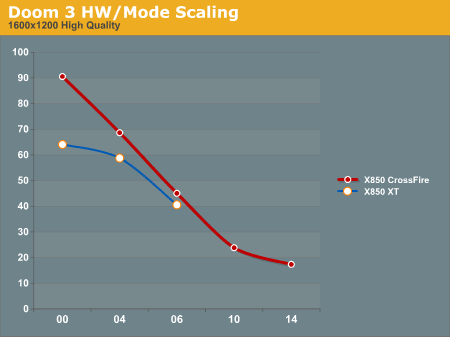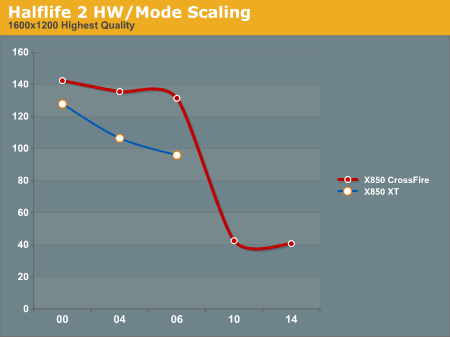ATI's X8xx CrossFire Graphics Arrive
by Derek Wilson on September 26, 2005 1:00 PM EST- Posted in
- GPUs
Mode and Hardware Scaling
There are two scaling factors we want to pay attention to here. First, we will be looking at how CrossFire scales with AA mode. As 8x and 10x share the same performance numbers (as do 12x and 14x), we will be looking at: no AA, 4xAA, 6xAA, 10xAA, 12xAA modes. We will be able to see just how steeply Super AA modes drop off in this test.We will also be looking at single card performance. It will be important to compare these numbers to the Super AA numbers, as each card in Crossfire mode should ideally be able to render the entire scene at single card speeds. Any difference between the Super AA modes and a single card running at either 4x or 6x AA account for the overhead of the communication system and compositing engine. The performance drop in these modes is more pronounced than in the other modes, as each card needs to render the entire scene at full frame rate. Any latency or bandwidth limitations will show up more easily here.
Our graphs show frames per second on the y-axis and AA mode across the x-axis.

Doom 3 shows a good performance increase due to CrossFire at standard AA settings. Both the single card and CrossFire setup are similarly GPU limited as AA increases. The drop from 4xAA on a single card to 10xAA on CrossFire is nearly 50%.
When we take a look at Half-Life 2, we see that a single card is fairly GPU limited with increasing AA while CrossFire handles it well. Going from single card AA modes to CrossFire Super AA modes shows more than a 50% drop in performance. This is likely due to the fact that as framerate increases, the impact of latency and bandwidth restrictions on transferring fully antialiased scenes from the slave to the master is proportionally greater.

Here's a look at how going from a single to a two card configuration scales under NVIDIA and ATI hardware under the games we tested.
| Multi GPU % Performance Improvement (16x12 noAA) | |||
| Doom 3 | Battlefield 2 | Half-Life 2 | |
| CrossFire | 41.3 | 53.8 | 15.8 |
| SLI | 34.0 | 89.3 | 22.2 |
| Multi GPU % Performance Improvement (16x12 4xAA) | |||
| Doom 3 | Battlefield 2 | Half-Life 2 | |
| CrossFire | 69.2 | 63.6 | 35.5 |
| SLI | 81.3 | 89.3 | 68.8 |
While Crossfire performs reasonably well without AA, the 4xAA modes show that SLI provides better scaling. More importantly, though, the lack of support for higher resolutions - as well as 1600x1200 at higher refresh rates - becomes a serious limitation of Crossfire. 7800 GTX SLI running at 2048x1536 has no competition from any ATI configuration for the time being.










76 Comments
View All Comments
erinlegault - Tuesday, September 27, 2005 - link
Well because the 1600x1200@60Hz is only a limitation because of the existing x800 family of cards and not the x850 family and definately not Crossfire itself.
Pete - Wednesday, September 28, 2005 - link
It's a limitation of the X8xx esries, as they all feature single-link TDMS transmitters, and so the Master cards have single-link TDMS receivers. They should be good for more than 16x12@72Hz, per DVI spec; hopefully future drivers will up this a bit.Plus, didn't The Inq show a pic of 19x12@52Hz?
vijay333 - Monday, September 26, 2005 - link
Valid points, don't see why some people are ranking this post down.Pete - Monday, September 26, 2005 - link
I really like how concise and readable the first few pages are.I do agree that comparing XF directly to the "2nd gen" SLI of the 7800 is a little unfair, but it's still potentially useful to some people, and you obviously left in XF's direct competitors, 6800 SLI and a single 7800. This does take the article in the 'too much info' direction, as opposed to the first few pages' 'just enough' method.
I have a few suggestions and corrections, if you don't mind.
* Perhaps you could elaborate on how XF will remove the res/refresh limitation with the R520 line-ups dual-link TDMS transmitters? This is appropriate in terms of the 7800 SLI comparison, although who knows when X1800 XF will show up.
* On that note, I've read elsewhere that SuperAA is so unbelievably slow because XF is actually using PCIe (bandwidth- and latency-limited) lanes and then the "master" GPU (for inter-GPU communication and then to composite the image, respectively), and not the dongle and CE (as with "normal" XF operation). This will supposedly be corrected in a future driver, but (IMO) it's as big a shortcoming (however temporary) as the (permanent, hardware-imposed) resolution limit. And I'm quite skeptical about future driver fixes, though it seems essential that ATI solve this one.
* p.6, you write "pre" instead of "per."
* p.7, "worth" instead of "worthy."
Will you be examining these issues at Ibiza, or will you have time before packing your sunscreen? :D
(And no, I'm not ignoring you, I'm just an incredibly slow and unimaginative thinker at times.)
DerekWilson - Monday, September 26, 2005 - link
I did mention that ATI's next gen part should remove the limitations of the single-link TMDS somewhere in there ... I am unable to go into detail at this time.I'll have to follow up on the PCIe rather than TMDS angle. That would make some sense to me though. All the subsamples from a single pixel may need to be in the same framebuffer in order for ATI to perform proper AA on them. It may be that the gamma adjustment causes some problems with doing a straight blend between the two scenes. Of course, that's speculation about speculation, so I wouldn't put much stock in my musings :-) As I said though, I'll follow up on this.
I fixed my typos. Thanks.
Glad you liked the article. And where I'm going next sunscreen won't be of much use. :-(
Also, I didn't think you were ignoring me. I've actually been pretty busy myself lately, so I completely understand.
tfranzese - Monday, September 26, 2005 - link
I'd appreciate it if all graphs had units attached. Numbers are certainly not good if they don't have units attached.OvErHeAtInG - Monday, September 26, 2005 - link
Is it the mode scaling you're worried about?From p 6: "Our graphs show frames per second on the y-axis and AA mode across the x-axis."
The rest of the sideways-historam-thingies show fps. That is pretty standard.
OvErHeAtInG - Monday, September 26, 2005 - link
I meant histogram, not historam. D'oh! And yes, I realize it's not really a histogram. Bar chart ? Ah! Who cares.OvErHeAtInG - Monday, September 26, 2005 - link
Or watts for the wattage graphs. :)Stefan - Monday, September 26, 2005 - link
Shouldn't we be comparing the Crossfire to the 6800 Ultra SLI and not the 7800 GTX SLI?I thought ATi's new X1800 Crossfire was going to be the 7800's counter. Or am I mistaken?